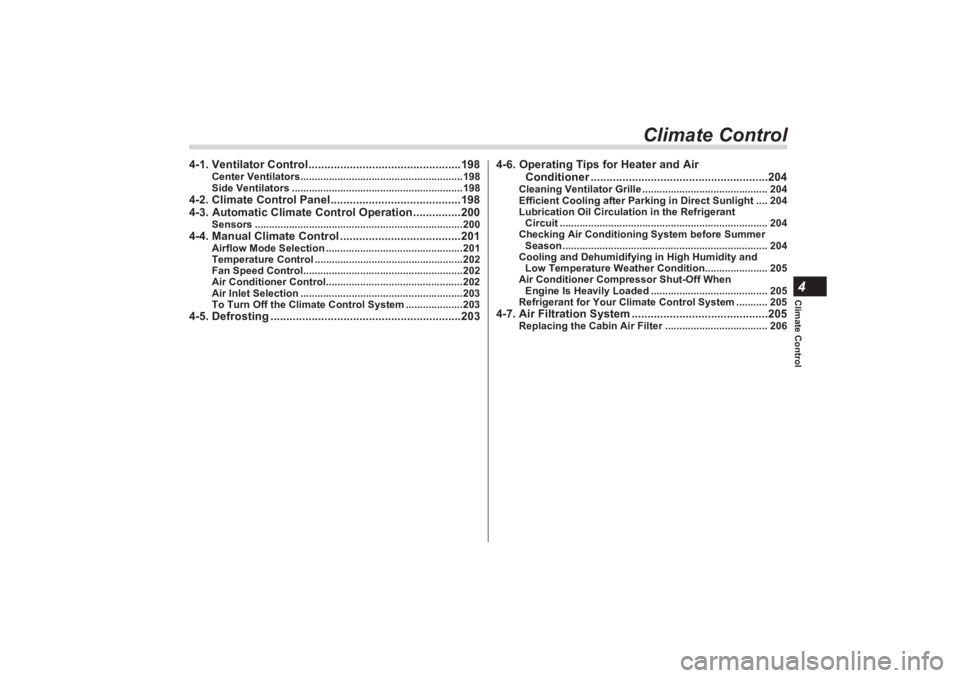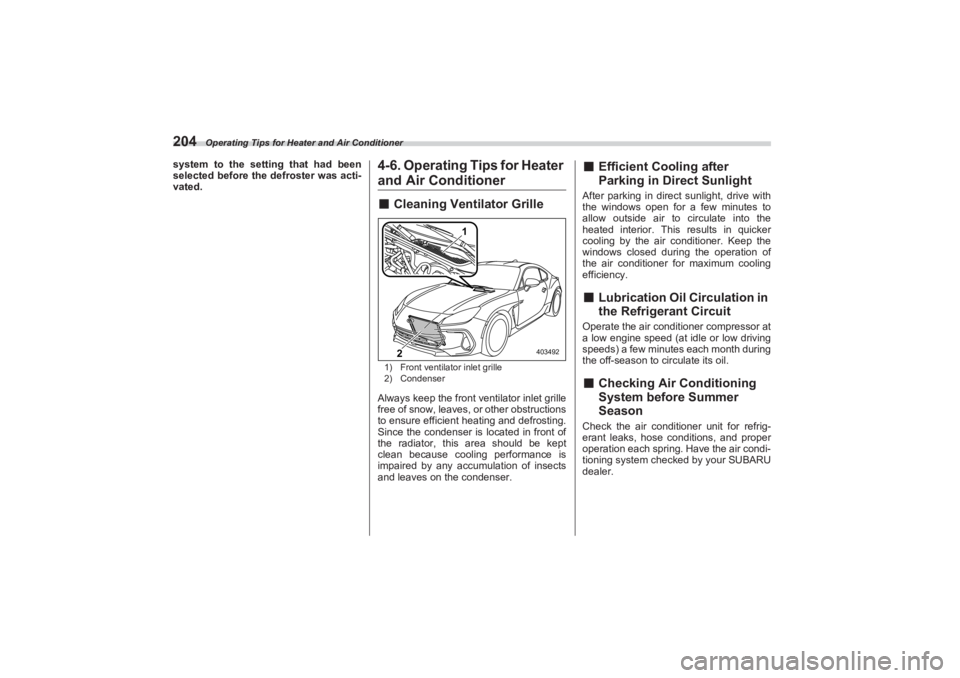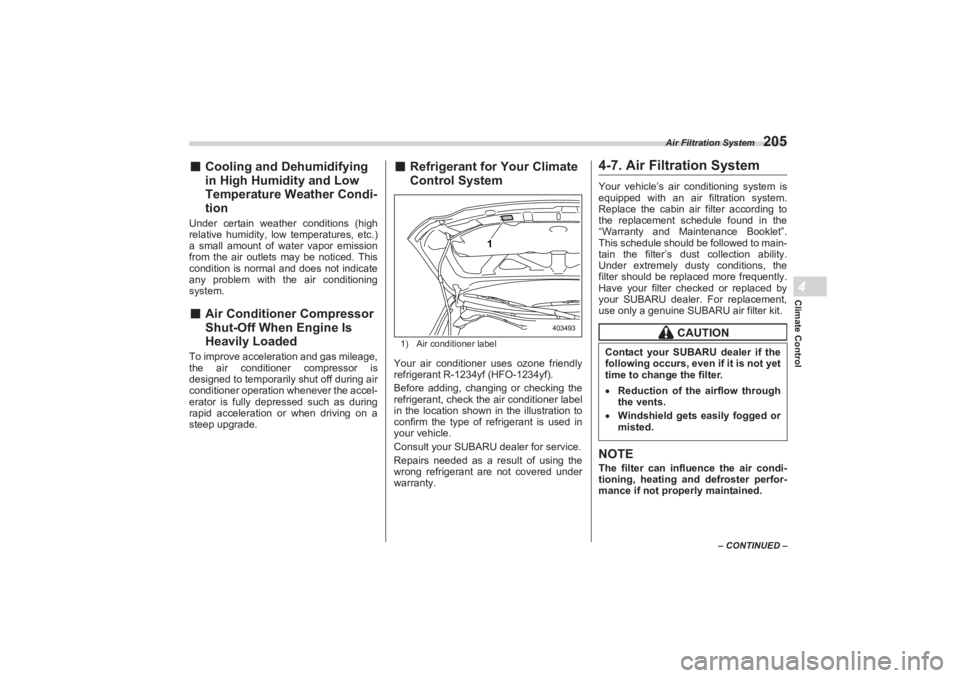2023 SUBARU BRZ air conditioning
[x] Cancel search: air conditioningPage 203 of 432

Climate Control4
Climate Control
4-1. Ventilator Control................................................198
Center Ventilators.........................................................198
Side Ventilators ............................................................198
4-2. Climate Control Panel.........................................198
4-3. Automatic Climate Control Operation...............200
Sensors .........................................................................200
4-4. Manual Climate Control ......................................201
Airflow Mode Selection ................................................201
Temperature Control ....................................................202
Fan Speed Control........................................................202
Air Conditioner Control................................................202
Air Inlet Selection .........................................................203
To Turn Off the Climate Control System ....................203
4-5. Defrosting ............................................................203 4-6. Operating Tips for Heater and Air
Conditioner ......... ....................................... ........204
Cleaning Ventilator Grille ............................................ 204
Efficient Cooling after Parking in Direct Sunlight .... 204
Lubrication Oil Circulation in the Refrigerant
Circuit ......................................................................... 204
Checking Air Conditioning System before Summer Season ........................................................................ 204
Cooling and Dehumidifying in High Humidity and
Low Temperature Weather Condition...................... 205
Air Conditioner Compressor Shut-Off When
Engine Is Heavily Loaded ......................................... 205
Refrigerant for Your Climate Control System ........... 205
4-7. Air Filtration System ...........................................205
Replacing the Cabin Air Filter .................................... 206
BRZ_U.book 197 ページ 2022年3月29日 火曜日 午後3時59分
Page 210 of 432

Operating Tips for Heater and Air Conditioner
204system to the setting that had been
selected before the defroster was acti-
vated.
4-6. Operating Tips for Heater and Air Conditioner■ Cleaning Ventilator Grille1) Front ventilator inlet grille
2) CondenserAlways keep the front ventilator inlet grille
free of snow, leaves, or other obstructions
to ensure efficient heating and defrosting.
Since the condenser is located in front of
the radiator, this area should be kept
clean because cooling performance is
impaired by any accu mulation of insects
and leaves on the condenser.
■ Efficient Cooling after
Parking in Direct SunlightAfter parking in direct sunlight, drive with
the windows open for a few minutes to
allow outside air to circulate into the
heated interior. This results in quicker
cooling by the air conditioner. Keep the
windows closed during the operation of
the air conditioner for maximum cooling
efficiency.■ Lubrication Oil Circulation in
the Refrigerant CircuitOperate the air conditioner compressor at
a low engine speed (at idle or low driving
speeds) a few minutes each month during
the off-season to circulate its oil.■ Checking Air Conditioning
System before Summer
SeasonCheck the air conditioner unit for refrig-
erant leaks, hose conditions, and proper
operation each spring. Have the air condi-
tioning system checked by your SUBARU
dealer.
2
1
403492
BRZ_U.book 204 ページ 2022年3月29日 火曜日 午後3時59分
Page 211 of 432

Air Filtration System
205
Climate Control4
– CONTINUED –
■Cooling and Dehumidifying
in High Humidity and Low
Te mperature Weather Condi -
tionUnder certain weather conditions (high
relative humidity, lo w temperatures, etc.)
a small amount of water vapor emission
from the air outlets may be noticed. This
condition is normal and does not indicate
any problem with the air conditioning
system.■ Air Conditioner Compressor
Shut-Off Whe n Engine Is
Heavily LoadedTo improve acceleration and gas mileage,
the air conditio ner compressor is
designed to temporarily shut off during air
conditioner operation whenever the accel-
erator is fully depressed such as during
rapid acceleration or when driving on a
steep upgrade.
■ Refrigerant for Your Climate
Control Syste m1) Air conditioner labelYour air conditioner uses ozone friendly
refrigerant R-1234yf (HFO-1234yf).
Before adding, changing or checking the
refrigerant, check the air conditioner label
in the location shown in the illustration to
confirm the type of refrigerant is used in
your vehicle.
Consult your SUBARU dealer for service.
Repairs needed as a result of using the
wrong refrigerant are not covered under
warranty.
4-7. Air Filtration SystemYour vehicle’s air conditioning system is
equipped with an air filtration system.
Replace the cabin air filter according to
the replacement schedule found in the
“Warranty and Maintenance Booklet”.
This schedule should be followed to main-
tain the filter’s dust collection ability.
Under extremely dusty conditions, the
filter should be replaced more frequently.
Have your filter checked or replaced by
your SUBARU dealer. For replacement,
use only a genuine SUBARU air filter kit.NOTEThe filter can influence the air condi-
tioning, heating and defroster perfor-
mance if not properly maintained.
1
403493
CAUTION
Contact your SUBARU dealer if the
following occurs, even if it is not yet
time to change the filter. Reduction of the airflow through
the vents. Windshield gets easily fogged or
misted.
BRZ_U.book 205 ページ 2022年3月29日 火曜日 午後3時59分
Page 404 of 432

Tire Information
398Cord separation
The parting of cords from adjacent
rubber compounds.
Cracking
Any parting within the tread,
sidewall, or inner liner of the tire
extending to cord material.
Curb weight
The weight of a motor vehicle with
standard equipment including the
maximum capacity of fuel, oil and
coolant, and if so equipped, air
conditioning and additional weight
optional engine.
Extra load tire
A tire designed to operate at higher
loads and higher inflation pressure
than the corresponding standard
tire.
Groove
The space between two adjacent
tread ribs.
Innerliner
The layer(s) forming the inside
surface of a tubeless tire that contains the inflating medium within
the tire.
Innerliner separation
The parting of the innerliner from
cord material in the carcass.
Intended outboard sidewall
(1) The sidewall that contains a
whitewall, bears white lettering or
bears manufacturer, brand, and/
or model name molding that is
higher or deeper than the same
molding on the other sidewall of
the tire, or
(2) The outward facing sidewall
of an asymmetrical tire that has a
particular side that must always
face outward when mounting on a
vehicle.
Light truck (LT) tire
A tire designated by its manufac-
turer as primarily intended for use
on lightweight trucks or multipur-
pose passenger vehicles.
Load rating
The maximum load that a tire is
rated to carry for a given inflation
pressure.
Maximum inflation pressure
The maximum cold inflation pres-
sure to which a tire may be inflated.
Maximum load rating
The load rating for a tire at the
maximum permissible inflation pres-
sure for that tire.
Maximum loaded vehicle
weight
The sum of:
(a) Curb weight
(b) Accessory weight
(c) Vehicle capacity weight
(d) Production options weight
Maximum permissible inflation
pressure
The maximum cold inflation pres-
sure to which a tire may be inflated.
Measuring rim
The rim on which a tire is fitted for
physical dimension requirements.
Normal occupant weight
150 lbs (68 kg) times the number of
occupants specified in the second
column of Table 1 that is appended
to the end of this section.BRZ_U.book 398 ページ 2022年3月29日 火曜日 午後3時59分